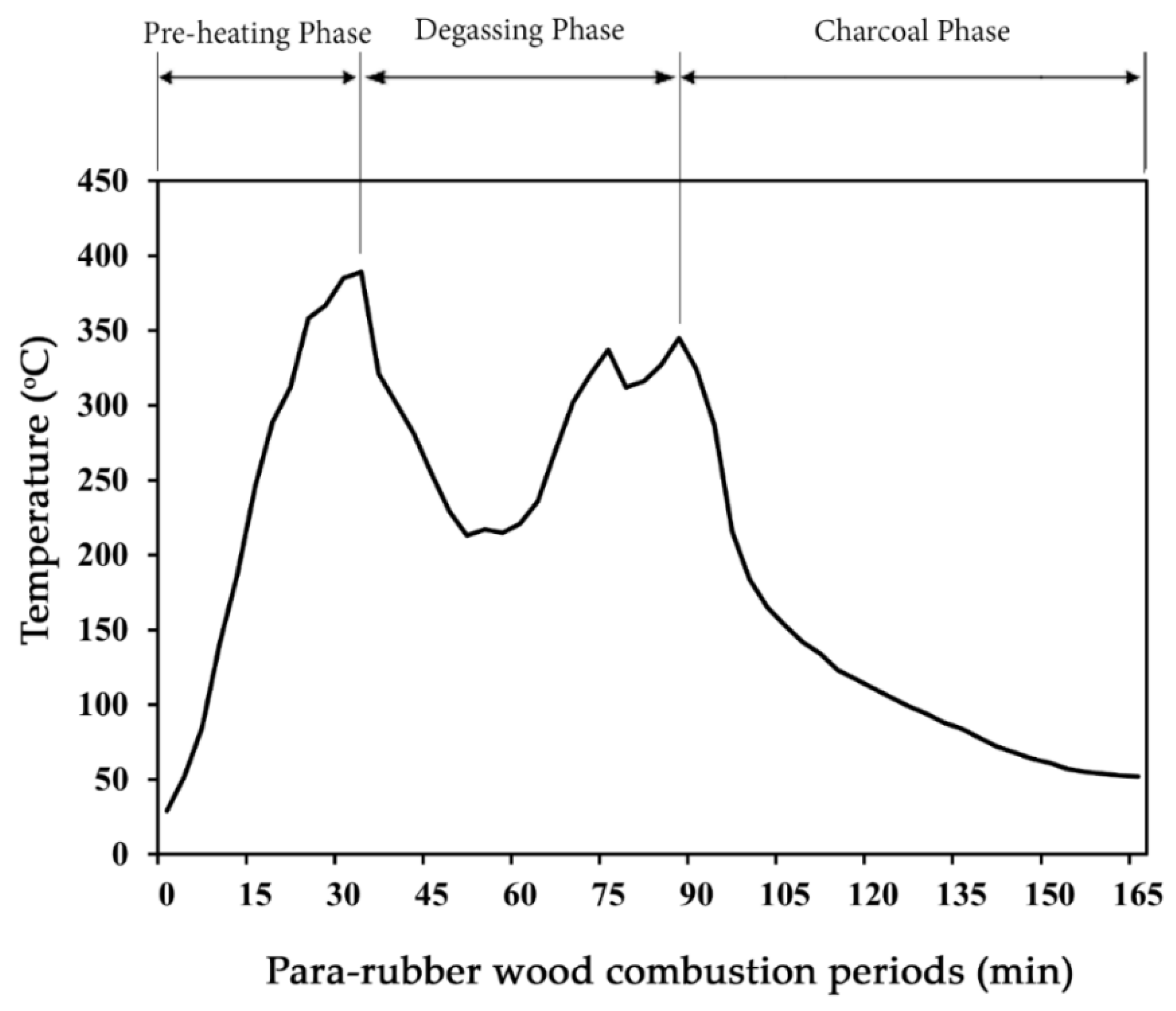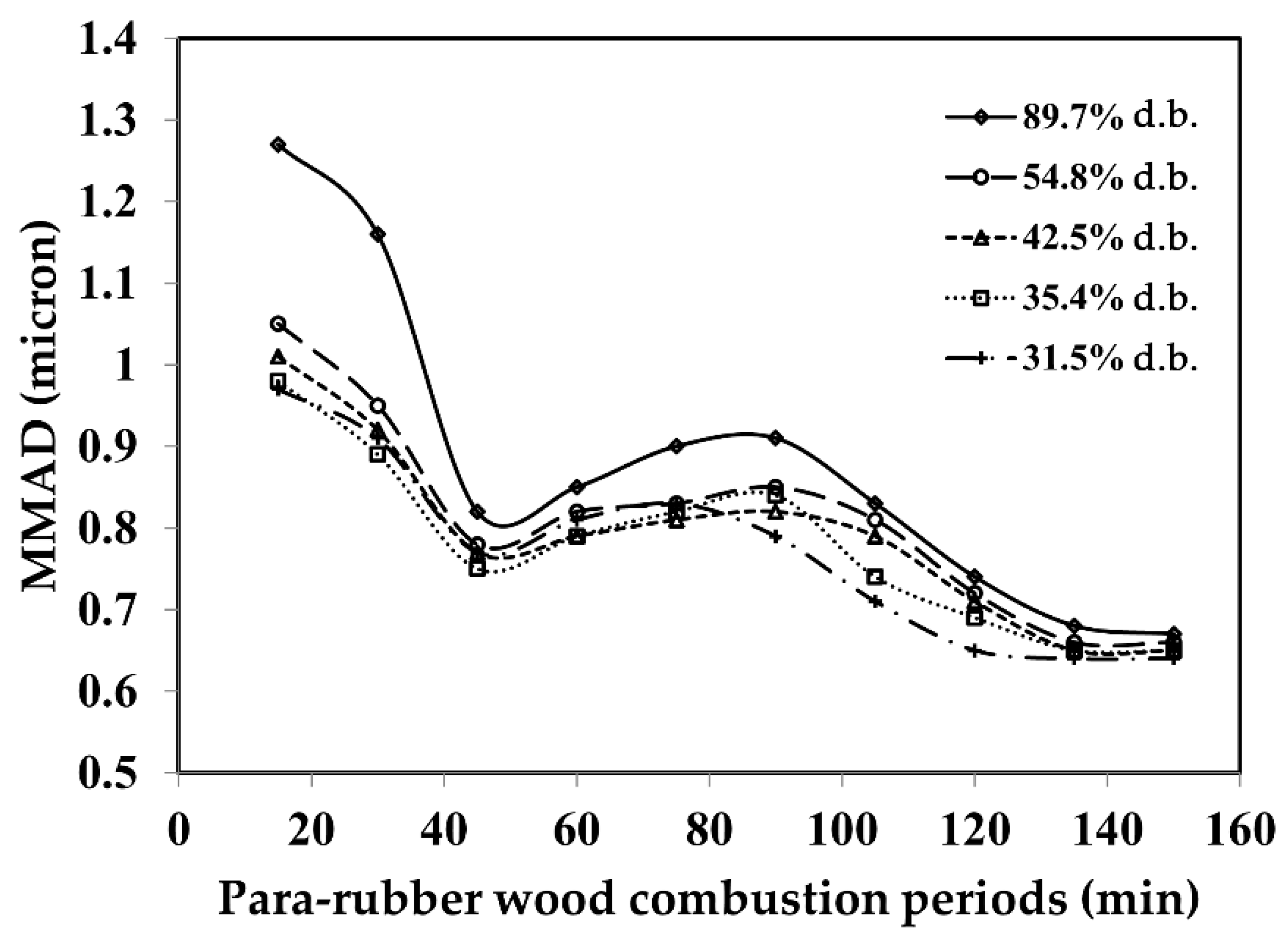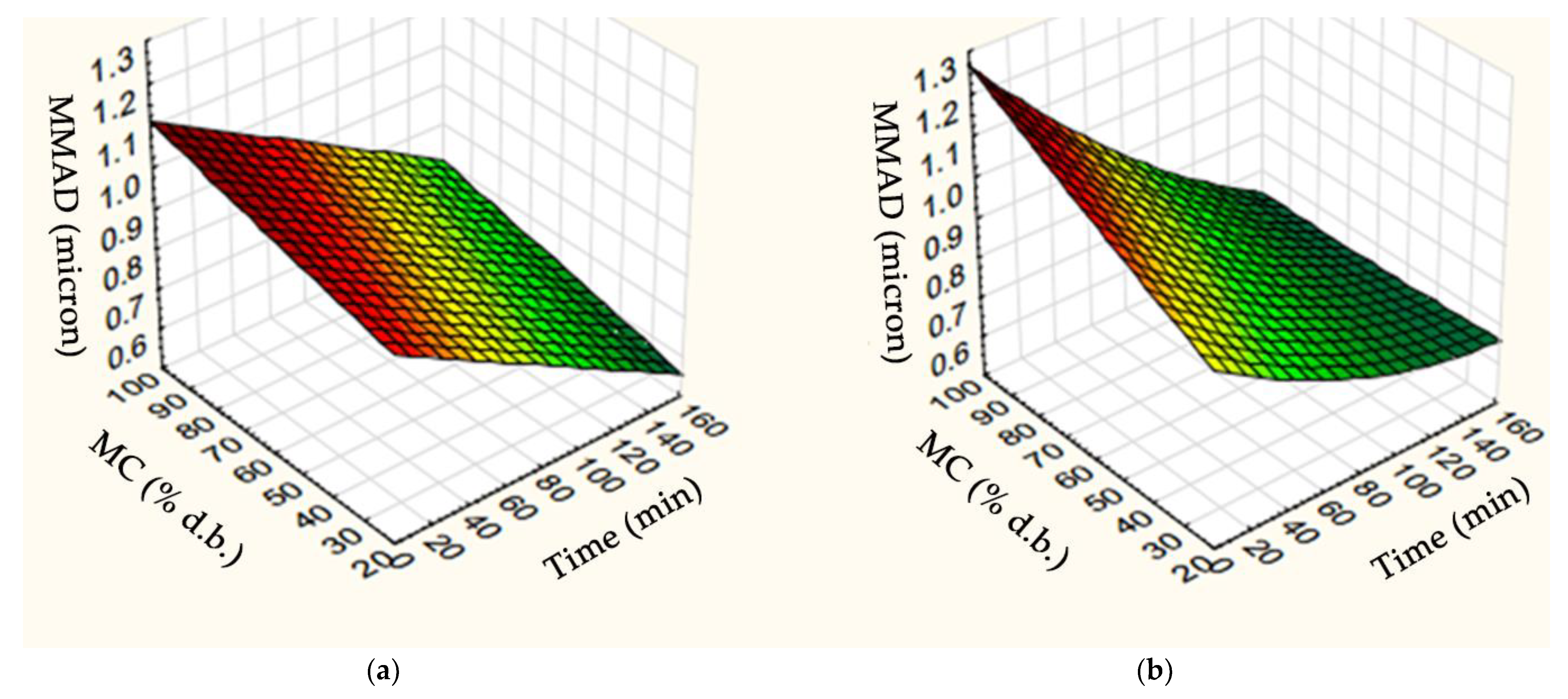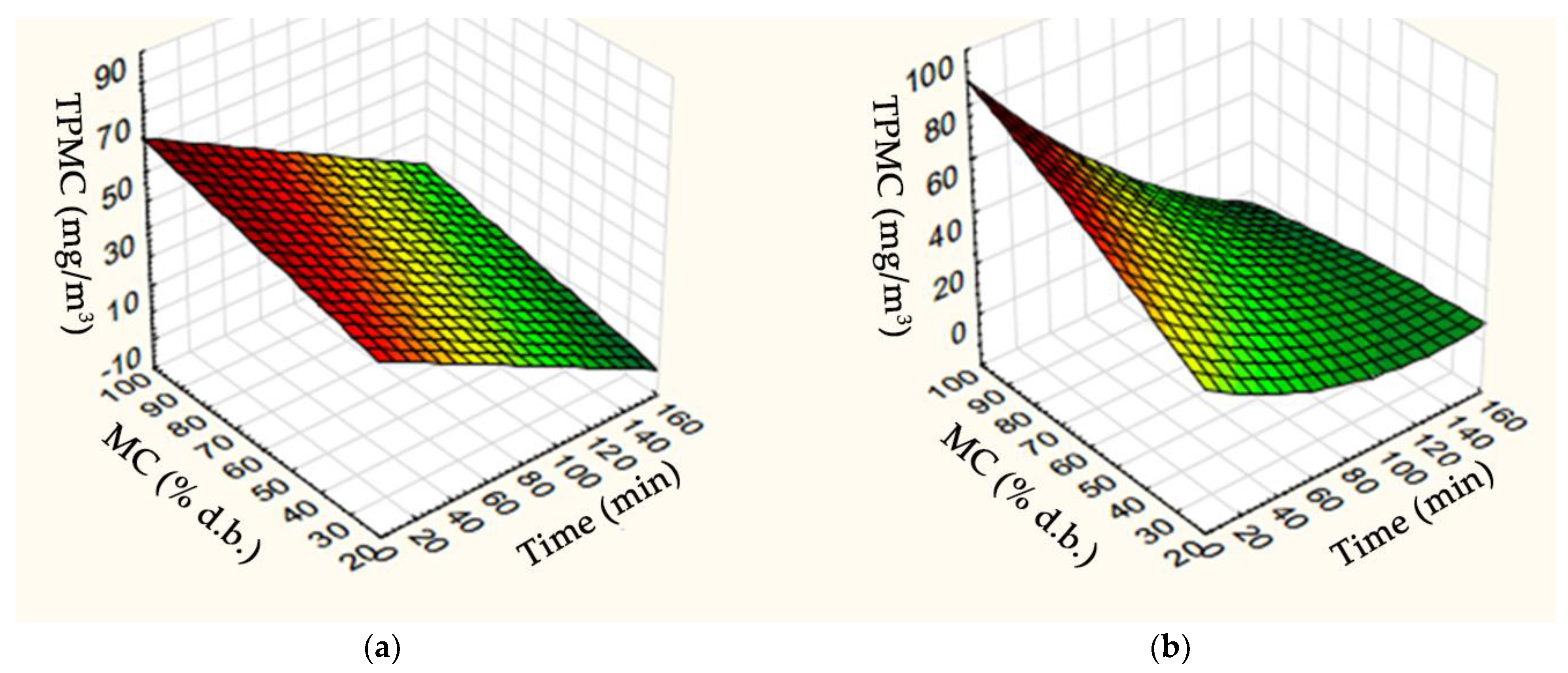Prediction of Size Distribution and Mass Concentration of Smoke Particles on Moisture Content and Combustion Period from Para Rubber Wood Burning
Abstract
1. Introduction
2. Materials and Methods
2.1. Biomass Fuel Used
2.2. Sampling Methods
2.3. Temperature Data Value Recording
2.4. Particles Size Distribution
2.5. Total Smoke Particle Mass Concentration
2.6. Modelling by Response Surface Method
3. Results and Discussion
3.1. Temperature Variation
3.2. Smoke Particle Size Distribution
3.3. Total Particle Mass Concentration of the Smoke Particles
3.4. Prediction of MMAD Values Change
3.5. Prediction of TPMC Values Change
4. Conclusions
Author Contributions
Funding
Institutional Review Board Statement
Informed Consent Statement
Acknowledgments
Conflicts of Interest
References
- Kalasee, W.; Tekasakul, S.; Otani, Y.; Tekasakul, P. Characteristic of soot particles produced from rubber-wood combustion. In Proceedings of the 2nd Asian Particle Technology Symposium, Penang, Malaysia, 17–19 December 2003. [Google Scholar]
- Tekasakul, P.; Furuuchi, M.; Tekasakul, S.; Chomanee, J.; Otani, Y. Characteristics of PAHs in particles in the atmospheric environment of Hat Yai city, Thailand, and relationship with rubber-wood burning in rubber sheet production. Aerosol Air Qual. Res. 2008, 8, 265–278. [Google Scholar] [CrossRef]
- Ekburanawat, J. Biomass pellets electrical power generation system by using gasification technology. RMUTI J. Sci. Technol. 2018, 11, 32–42. [Google Scholar]
- Simonelt, B.R.T.; Rogge, W.F.; Mazurek, M.A.; Standley, L.J.; Hildemann, L.M.; Cass, G.R. Lignin pyrolysis products, Lignans, and Resin Acids as specific tracers of plant classes in emissions from biomass combustion. Environ. Sci. Technol. 1993, 27, 2533–2541. [Google Scholar] [CrossRef]
- McDonald, J.; Zielinska, B.; Fujita, E.; Sagebiel, J.; Chow, G.; Watson, J. Fine Particle and Gaseous Emission Rates from Residential Wood Combustion. Environ. Sci. Technol. 2000, 34, 2080–2091. [Google Scholar] [CrossRef]
- Venkataraman, C.; Negi, G.; Sardar, S.B.; Rastogi, R. Size distributions of polycyclic aromatic hydrocarbons in aerosol emission from biofuel combustion. J. Aerosol Sci. 2002, 33, 503–518. [Google Scholar] [CrossRef]
- Shen, G.; Preston, W.; Ebersviller, S.; Williams, C.; Faircloth, J.; Jetter, J.; Hay, M. Polycyclic aromatic hydrocarbons in fine particulate matter emitted from burning kerosene, liquid petroleum gas, and wood fuels in household cook-stoves. Energy Fuels 2017, 31, 3081–3090. [Google Scholar] [CrossRef]
- Choosong, T.; Furuuchi, M.; Tekasakul, P.; Tekasakul, S.; Chomanee, J.; Jinno, T.; Hata, M.; Otani, Y. Working environment in a rubber sheet smoking factory polluted by smoke from biomass fuel burning and health influences to worker. J. Ecotechnol. Res. 2007, 13, 91–96. [Google Scholar]
- Xu, X.; Cook, R.; Ilacqua, V.; Kan, H.; Talbott, E.; Kearney, G. Studying associations between urinary metabolites of polycyclic aromatic hydrocarbons (PAHs) and cardiovascular diseases in the United States. Sci. Total Environ. 2010, 408, 4943–4948. [Google Scholar] [CrossRef] [PubMed]
- Langton, A.R.; Romero, M.T.; Boman, G.V.; Brooks, B.; Wilson, A.J.; Atika, F.; Bartle, K.; Jones, J.M.; Williams, A. A study of smoke formation from wood combustion. Fuel Process. Technol. 2015, 137, 327–332. [Google Scholar] [CrossRef]
- Pham, C.; Boongla, Y.; Nghiem, T.; Le, H.; Tang, N.; Toriba, A.; Hayakawa, K. Emission characteristics of polycyclic aAromatic hydrocarbons and nitro-polycyclic aromatic hydrocarbons from open burning of rice straw in the north of Vietnam. Int. J. Environ. Res. Public Health 2019, 16, 2343. [Google Scholar] [CrossRef]
- Kalasee, W. Improvement soot particles separation equipments for rubber smoking chamber. Aerosol Air Qual. Res. 2009, 9, 333–341. [Google Scholar] [CrossRef]
- Rattanamechaiskul, C.; Junka, N.; Potichalung, J.; Wingwon, T.; Boontum, W.; Srisang, N. Whiteness index prediction of para rubber sheet during hot air drying. KKU Eng. J. 2016, 43, 331–333. [Google Scholar]
- Kalasee, W. Improvement of Rubber Smoke Room by Hot Gas Filtration of the Smoke Prior to Direct Heat Transfer with Rubber Sheets. Master’s Thesis, Prince of Songkla University, Songkhla, Thailand, 2005. [Google Scholar]
- Furuuchi, M.; Tekasakul, P.; Murase, T.; Otani, Y.; Tekasakul, S.; Bai, Y. Characteristics of particulates emitted from rubber-wood burning. J. Ecotechnol. Res. 2006, 12, 135–139. [Google Scholar]
- Choosong, T.; Chomanee, J.; Tekasakul, P.; Tekasakul, S.; Otani, Y.; Hata, M.; Furuuchi, M. Workplace environment and personal exposure of PM and PAHs to workers in natural rubber sheet factories contaminated by wood burning smoke. Aerosol Air Qual. Res. 2010, 10, 8–21. [Google Scholar] [CrossRef]
- Hata, M.; Chomanee, J.; Thongyen, T.; Bao, L.; Tekasakul, S.; Tekasakul, P.; Otani, Y.; Furuuchi, M. Characteristics of nanoparticles emitted from burning of biomass fuels. J. Environ. Sci. 2014, 26, 1913–1920. [Google Scholar] [CrossRef] [PubMed]
- Chomanee, J.; Tekasakul, S.; Tekasakul, P.; Furuuchi, M.; Otani, Y. Effects of moisture content and burning period on concentration of smoke particles and particle-bound polycyclic aromatic hydrocarbons from rubber-wood combustion. Aerosol Air Qual. Res. 2009, 9, 404–411. [Google Scholar] [CrossRef]
- Riyaphan, J.; Phumichai, T.; Neimsuwan, T.; Witayakran, S.; Sungsing, K.; Kaveeta, R.; Phumichai, C. Variability in chemical and mechanical properties of para rubber (Hevea brasiliensis) trees. Sci. Asia 2015, 41, 251–258. [Google Scholar] [CrossRef]
- Hinds, W.C. Aerosol Technology, 2nd ed.; John Wiley & Sons: New York, NY, USA, 1999. [Google Scholar]
- Smit, H.C.; Meincken, M. Time/temperature combustion profiles of various wood-baseed biofuels. Biomass Bioenergy 2012, 39, 317–323. [Google Scholar] [CrossRef]
- Hagen, B.C. Onset of Smoldering and Transition to Flaming. Ph.D. Thesis, University of Bergen, Bergen, Norway, 2013. [Google Scholar]
- Meincken, M.; Funk, S. Burning Characteristics of low-cost safety charcoal briquettes made from wood residues and soil for domestic use. Agrofor. Syst. 2015, 89, 357–363. [Google Scholar] [CrossRef]
- Munalula, F.; Meincken, M. An evaluation of South African fuelwood with regards to calorific value and environmental impact. Biomass Bioenergy 2009, 33, 415–420. [Google Scholar] [CrossRef]
- Mwampamba, T.H.; Owen, M.; Pigaht, M. Opportunities, challenges and way forward for the charcoal briquette industry in sub-Saharan Africa. Energy Sustain. Dev. 2013, 17, 158–170. [Google Scholar] [CrossRef]
- Tekasakul, S.; Tantichaowanan, M.; Otani, Y.; Kuruhongsa, P.; Tekasakul, P. Removal of soot particles in rubber smoking chamber by electrostatic precipitator to improve rubber sheet color. Aerosol Air Qual. Res. 2006, 6, 1–14. [Google Scholar] [CrossRef]
- Kocbach, A.; Johansen, B.V.; Schwarze, P.E.; Namork, E. Analytical electron microscopy of combustion particles: A comparison of vehicle exhaust and residential wood smoke. Sci. Total. Environ. 2005, 346, 231–243. [Google Scholar] [CrossRef] [PubMed]
- Tissari, J.; Hytonen, K.; Lyyränen, J.; Jokiniemi, J. A novel field measurement method for determining fine particle and gas emissions from residential wood combustion. Atmos. Environ. 2007, 41, 8330–8344. [Google Scholar] [CrossRef]
- Wiinikka, H.; Gebart, R.; Boman, C.; Bostrom, D.; Ohman, M. Influence of fuel ash composition on high temperature aerosol formation in fixed bed combustion of woody biomass pellets. Fuel 2007, 86, 181–193. [Google Scholar] [CrossRef]
- Mopoung, S.; Udeye, V. Characterization and evaluation of charcoal briquettes using banana peel and banana bunch waste for household heating. Am. J. Eng. Appl. Sci. 2017, 10, 353–365. [Google Scholar] [CrossRef]
- Bolling, A.; Pagels, J.; Yttri, K.; Barregard, L.; Sallsten, G.; Schwarze, P.; Boman, C. Health effects of residential wood smoke particles: The importance of combustion conditions and physicochemical particle properties. Part. Fibre Toxicol. 2009, 6, 1–6. [Google Scholar]
- Battin-Leclerc, F.; Simmie, J.M.; Blurock, E. Cleaner Combustion: Developing Detailed Chemical Kinetic Models, 1st ed.; Springer: New York, NY, USA, 2013; ISBN 978-1-4471-6909-3. [Google Scholar]
- Song, M.; Lee, K.; Oh, S.-H.; Bae, M.-S. Impact of polycyclic aromatic hydrocarbons (PAHs) from an asphalt mix plant in a suburban residential area. Appl. Sci. 2020, 10, 4632. [Google Scholar] [CrossRef]
- Song, M.; Park, C.; Choi, W.; Park, M.; Lee, K.; Park, K.; Park, S.; Bae, M.-S. Organic molecular marker from regional biomass burning—direct application to source apportionment model. Appl. Sci. 2020, 10, 4449. [Google Scholar] [CrossRef]
- Williams, A.; Jones, J.M.; Ma, L.; Pourkashanian, M. Pollutants from the combustion of solid biomass fuels. Prog. Energy Combust. Sci. 2012, 38, 113–137. [Google Scholar] [CrossRef]









| Type of Andersen Air Sampler System | Moisture Content (% d.b.) | Burning Period (min) | MMAD (Micron) | TPMC (mg/m3) |
|---|---|---|---|---|
| Normal | 89.70% | 15 | 1.37 | 79.28 |
| 30 | 1.29 | 62.59 | ||
| 45 | 0.91 | 49.14 | ||
| Modified | 89.70% | 15 | 1.25 | 77.42 |
| 30 | 1.16 | 61.51 | ||
| 45 | 0.82 | 48.23 |
| Degree in Model | Coefficient | |||||
|---|---|---|---|---|---|---|
| First | 0.9205 | −0.0025 | 0.0019 | - | - | - |
| Second | 0.8661 | −0.0027 | 0.0036 | 9.09 × 10−6 | −2.69 × 10−5 | 4.12 × 10−6 |
| Model Degree | Coefficient | |||||
|---|---|---|---|---|---|---|
| First | 36.1114 | −0.3261 | 0.2518 | - | - | - |
| Second | 18.6865 | −0.3399 | 0.8332 | 0.0017 | −0.0051 | −0.0013 |
Publisher’s Note: MDPI stays neutral with regard to jurisdictional claims in published maps and institutional affiliations. |
© 2021 by the authors. Licensee MDPI, Basel, Switzerland. This article is an open access article distributed under the terms and conditions of the Creative Commons Attribution (CC BY) license (https://creativecommons.org/licenses/by/4.0/).
Share and Cite
Kalasee, W.; Dangwilailux, P. Prediction of Size Distribution and Mass Concentration of Smoke Particles on Moisture Content and Combustion Period from Para Rubber Wood Burning. Appl. Sci. 2021, 11, 5649. https://doi.org/10.3390/app11125649
Kalasee W, Dangwilailux P. Prediction of Size Distribution and Mass Concentration of Smoke Particles on Moisture Content and Combustion Period from Para Rubber Wood Burning. Applied Sciences. 2021; 11(12):5649. https://doi.org/10.3390/app11125649
Chicago/Turabian StyleKalasee, Wachara, and Panya Dangwilailux. 2021. "Prediction of Size Distribution and Mass Concentration of Smoke Particles on Moisture Content and Combustion Period from Para Rubber Wood Burning" Applied Sciences 11, no. 12: 5649. https://doi.org/10.3390/app11125649
APA StyleKalasee, W., & Dangwilailux, P. (2021). Prediction of Size Distribution and Mass Concentration of Smoke Particles on Moisture Content and Combustion Period from Para Rubber Wood Burning. Applied Sciences, 11(12), 5649. https://doi.org/10.3390/app11125649





